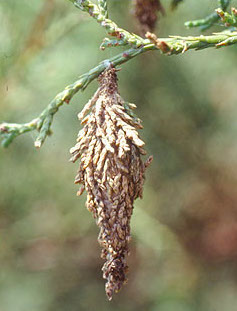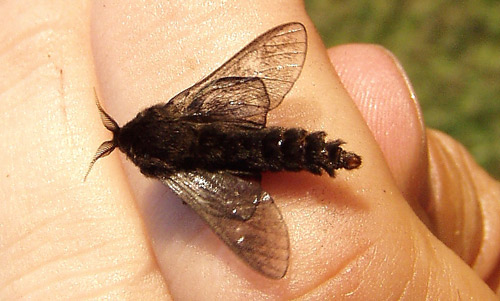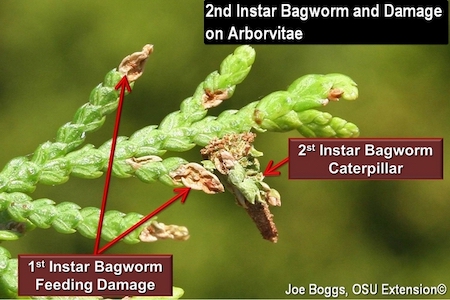Their Bags Are Packed and Ready to Go
By Carolyn R. Casey, Fairfax Master Gardener
 Have you seen cute, brown diamond-shaped objects hanging from your evergreen shrub that look like holiday ornaments? Do not be deceived! These are anything but cute; they are bagworms (Thyridopteryx ephemeraeformis)! These are the larvae or caterpillar stages of moths. They are found on juniper, arborvitae, cedar, pine, hemlock, spruce, Chinese elm and honey locust, as well as crabapple, maple, sycamore, box elder, willow, linden and poplar. They are known to eat the leaves and needles from 128 different trees and shrubs. Bagworms can be found from New England to Nebraska and through Texas. They are often hiding in plain sight.
Have you seen cute, brown diamond-shaped objects hanging from your evergreen shrub that look like holiday ornaments? Do not be deceived! These are anything but cute; they are bagworms (Thyridopteryx ephemeraeformis)! These are the larvae or caterpillar stages of moths. They are found on juniper, arborvitae, cedar, pine, hemlock, spruce, Chinese elm and honey locust, as well as crabapple, maple, sycamore, box elder, willow, linden and poplar. They are known to eat the leaves and needles from 128 different trees and shrubs. Bagworms can be found from New England to Nebraska and through Texas. They are often hiding in plain sight.
Description and Lifestyle of Bagworms
Bagworm eggs hatch in early June, and the small brown to black larvae begin to build small silken bags around themselves and begin eating. The larvae and bags stay small (one-fourth inch or 6 mm long) for a few weeks. They are difficult to see because they are so small, except when they stick their heads out of the bags. As the larvae hatch, they crawl out of the bags and drop down on strands of silk. They may be picked up by the wind and carried to nearby plants.
When they find plants that they like, they will begin to create new bags over their bodies. Bagworms carry their bags with them as they travel from one plant to another. They travel from tree to tree by ballooning. This method uses wind and a fine web that they spin. Bagworms stick their heads and front legs out of the bag to feed and move. When they are disturbed, they quickly bring their heads back into the bag and close the opening. Their bags are made of silk strands and pieces of leaves, needles and twigs. The larvae’s bags protect them as they eat from their natural enemies.
As the larvae continue to grow they enlarge their bags with additional pieces of foliage. In late August the bags are now almost 2 inches long and the larvae are about 1 inch long. They will continue to eat and molt until August when pupation happens. Before molting and pupation the larvae attach their bags to branches or other structures with strong bands of silk strands and close the opening to protect the larvae. The larvae will now position themselves with their heads down and pupate.

Bagworm adult
In about four weeks the males will emerge from the bags. The males have clear wings and fur on their bodies. They are able to fly and leave the bags to mate with females through the bag entrances. The females become moths that are wingless with no functional legs and remain in the bags where they will lay the eggs for the next generation. Bagworms will produce a single generation each year. The female bagworm lays between 300 to 1,000 eggs in her bag. After she mates the female mummifies herself around her egg mass. The eggs stay in the bags on the trees and shrubs until the next spring and hatch in early June, and the cycle starts all over again.
Damage Caused by Bagworms
Bagworms are a serious pest that can cause extensive defoliation and permanent injuries on evergreens. Defoliation of host plants increases from June until late July and August. Plants can show signs of defoliation and may be weakened and appear unsightly. Damage to the foliage is more noticeable in the uppermost parts of trees and shrubs. Larvae may eat buds on conifers which causes branch dieback and open dead areas.

Initial bagworm damage
Excessive defoliation of conifers may lead to their death. The bands of silk that the bagworms use to attach to trees and shrubs prior to pupating do not decay quickly. They can girdle the branches as they grow and lead to dead branches years later. So, it is very important to prune off the silk bands with a small portion of the branches when taking the bags off of plants. Completely defoliated trees usually will make a full recovery the next spring if they are otherwise healthy and were planted correctly. Bagworms are not easily seen until August after the severe damage has occurred.
Ways to Control Bagworms
One way to control bagworms is to remove their nests by hand, remembering to cut off the silk threads that are attaching the nests to the plants. Place all of the nests in a plastic bag and seal them or place them into a jar with soapy water with a lid. You want to completely destroy the nests. Do not put them in your compost pile or in your yard waste bin for pick up. This needs to be done before the bagworm eggs hatch. It is important to treat for bagworms in mid-June when the larvae are small since they are more susceptible to insecticides.
Larger and molting larvae are not as easily killed. From fall to spring the bags can be picked off and destroyed. This will help to diminish their population before the next generation hatches in early June. It is important to examine your trees and shrubs in the fall, winter or early spring each year to detect infested plants before serious damage happens.
There are also a biological control, Bacillus thuringiensis or Bt, a bacteria that kills only certain insects and does not affect humans or animals. Bt needs to be applied by mid-July since it works best on young bagworms. It is available under the brand names Dipel, Thuricide and others. It may be necessary to treat your plants more than once. Parasitic wasps can also be used to control bagworms.
Insecticide will provide control if applied thoroughly to all infested foliage in early to mid-June. This needs to be done while bags are less than one-half inch long. The label needs to list that it is a treatment for bagworms and for use on the plant you want to treat. You can lightly mist the foliage of the plants; mist blower treatments are also effective. Some commonly used pesticides are Bifenthrin, Carbaryl, Permethrin, Imidacloprid, Malathion, Esfenvalerate, Neem Oil, Pyrethrins, Soybean Oil and Spinosad. Do not use more toxic or hazardous materials in public areas or around homes. The use of Sevin may lead to an increase in mites. Always read the label and follow the directions.
Bagworms will consume that nice evergreen that, if left unattended, may be destined for the landfill. They could be hiding in your bushes or your neighbor’s. So be on the lookout for these pesky varmints; their bags are packed and need to go. Like unwanted house guests, it’s time for them to depart. So make sure that their final destination is in a zip lock bag or jar of soapy water. Happy hunting.
References
• How Can I Control Bagworms on my Spruce Tree?, Iowa State University Extension and Outreach,
Horticulture and Home Pest News
• Bagworm, Iowa State University Extension and Outreach, Horticulture and Home Pest News
• Bagworms on Trees and Shrubs, University of Maryland Extension, Home and Garden
Information Center
• Bagworm, Eric Day, Virginia Cooperative Extension
• Bagworm and Its Control, D.J. Shetlar, Ohioline, Ohio State University Extension
• Pest Management Guide: Home Grounds and Animals, 2021, Virginia Cooperative Extension